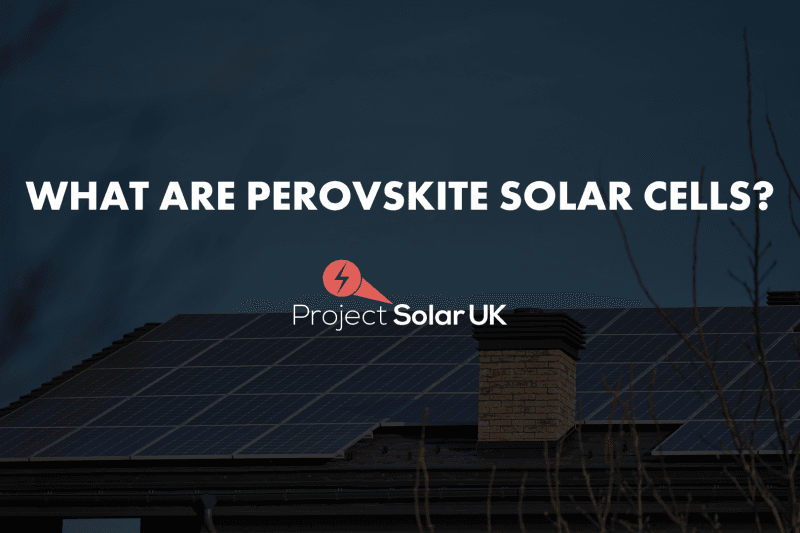The world’s first silicon photovoltaic (PV) cell was developed in a US laboratory by scientists in 1954. Since then, it’s fair to say that solar technology has made significant progress.
We’re now looking at the possibility of harnessing solar power from space-based systems, and researchers are working tirelessly every day to transform the efficiency of domestic and commercial systems.
One such invention paving the way for high-performance, low-production panels is perovskite solar cells.
While we offer the most reliable solar systems on the market, here’s an update on what could be one of the most promising technologies the world has seen so far.
What are perovskites?
Perovskites are a class of materials defined by a unique crystal structure first discovered in the mineral calcium titanium oxide (which was later named after Russian mineralogist Lev Perovski!)
The term “perovskite” can refer both to this specific mineral and to any compound that shares its characteristic crystal lattice.
Their structure allows for a wide variety of chemical compositions: this is what gives perovskites their diverse physical, optical, and electronic properties.
What are perovskite solar cells?
Perovskite solar cells (PSCs) operate using a perovskite-structured compound.
These cells have gained rapid attention due to their high efficiency and relatively low production costs. Since their creation, the efficiency of perovskite solar cells has increased significantly, with laboratory models now surpassing 25%.
How are perovskite solar cells made?
At the time of publication, scientists are currently manufacturing perovskite solar cells using two main production methods: vacuum evaporation and solution-based approaches.
Solution-based approaches
Solution-based approaches often involve a technique called ‘spin-coating’.
In this method, a solution containing the perovskite is deposited onto a substrate that spins at high speeds to create a uniform thin film.
Solution-based techniques are popular in research settings due to their simplicity, cost-effectiveness, and ability to produce high-performing devices. However, it’s not easily scalable for industrial production.
Vacuum evaporation
For industrial-scale production, vacuum evaporation, a type of physical vapour deposition (PVD), is more suitable. The perovskite is heated up in a vacuum chamber until it evaporates and coats the substrate.
What are the advantages of perovskite solar cells?
So, why are scientists so interested in developing perovskite solar cells beyond current capabilities?
-
Low manufacturing costs
One of the most compelling advantages of perovskite solar cells is their low manufacturing costs.
Traditional silicon-based solar cells require energy-intensive processes and expensive materials, which significantly drive up costs. Perovskite solar cells, however, can be produced using simpler, less energy-intensive methods.
According to research, the cost-effectiveness of perovskite solar cells comes from the ability to manufacture them at lower temperatures and through more straightforward chemical processes.
-
Potential for greater light absorption
Perovskite solar cells could offer superior light absorption properties. The unique crystalline structure of perovskites allows for excellent light-harvesting capabilities across a broad spectrum of sunlight.
The ability to tune the band gap of perovskite materials means they could capture and convert sunlight into electricity more effectively.
-
Lightweight and flexible
Perovskite solar cells can be deposited on a variety of flexible substrates, including plastics, textiles, and even paper. Their flexibility opens up new possibilities for solar energy applications, particularly in areas where traditional panels are impractical.
For example, flexible perovskite solar cells could be integrated into building materials, wearable electronics, and portable devices, effectively expanding the range of environments where solar power can be used.
What are the disadvantages of perovskite solar cells?
Despite the hype around perovskite solar cells, they’re not yet available for purchase because of the following issues:
-
Vulnerable to environmental conditions
Perovskite solar cells (PSCs) are notably sensitive to environmental factors such as moisture, oxygen, and heat. The exposure to water can lead to the dissolution of the perovskite material, which then results in significant degradation of performance.
Prolonged exposure to oxygen and light can also cause the formation of reactive superoxides that degrade the cell’s efficiency.
Heat is another detrimental factor. Many perovskite materials, especially those containing lead halides, can decompose under thermal stress, which releases halogen gases and leads to the breakdown of the cell structure.
The instability of PSCs under these conditions presents a substantial challenge to their long-term use and commercial viability.
-
Limits to efficiency
Despite achieving high-efficiency rates in laboratory settings, PSCs face practical challenges in maintaining these efficiencies over time.
Issues such as current-voltage hysteresis, where the voltage output of the cell fluctuates under different operating conditions, can severely impact the operational performance of the cells.
While advancements such as tandem cell technologies, which combine perovskite layers with silicon, have shown promise, current production methods still need to be refined to achieve reliable, high-efficiency outputs in real-world applications.
-
Lead
One of the major environmental and health concerns with PSCs is the use of lead in their composition. Lead is a toxic heavy metal that poses significant health risks during the manufacturing, usage, and disposal of solar panels.
If a perovskite solar panel breaks and is exposed to rain, the lead can leach into water sources, causing environmental contamination.
Efforts to develop lead-free alternatives have so far been unsuccessful, as these substitutes have yet to match the performance levels of lead-based perovskites.
Join the Solar Takeover!
While it’s unclear if perovskite solar cells are set to revolutionise the world of green technology, current experiments have yielded promising results. In the meantime, why not invest in a reliable PV system from Project Solar? If you’re in the market for a residential or commercial solar panel array for your home or business, contact us today for more information.

